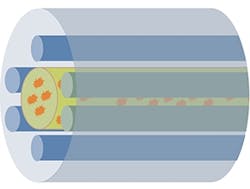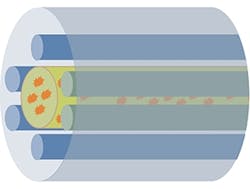Liquid-filled hollow optical fibers show promise for biosensing
Processing biological samples on a small substrate the size of a computer chip is becoming commonplace, but the small working area makes probing samples on the substrate with light difficult. Recognizing this, Xia Yu and colleagues at the A*STAR Singapore Institute of Manufacturing Technology have developed an optical fiber system that can deliver light to microfluidic chips, or biosensors, with high efficiency.
In probing biological samples with light, the sample is excited by an external light source and the light emitted in response is detected, which provides a unique fingerprint of the substance. Conventional techniques are able to deliver light to samples and probe the response, but they are not very efficient at probing a small sample volume. A solution to this is to use optical fibers that are able to guide light to small spaces. The drawback with this technique, however, has been that it can be difficult to insert the external probe light into the optical fiber with sufficient efficiencies.
Yu and her co-workers have now circumvented this problem by using optical fibers with a hollow core. The empty hollow core can be filled with liquidsâin this case, with chemiluminescent solutions. The liquid is important to promote the transport of light through the core. In addition, these solutions consist of two liquids that when brought together initiate a chemical reaction that emits light. If such a solution is placed directly within the hollow core, the problem of coupling light into the fiber is circumvented. This not only avoids external light sources, but also promotes an established technology.
âThe use of chemical luminescence is a common technique for a variety of detection assays in biology,â says Yu. âBy incorporating the emission mechanism into optical fibers, we can use it as a light source for sensing applications in microfluidics systems.â
First tests for such sensing applications are already underway, although some challenges remain. For example, there might be losses in the light emitted by the fluid if the emitted light is not perfectly confined within the fiber. Such problems can be solved through improved fiber designs and an appropriate choice of materials, and applications of these fibers for microfluidic systems are promising.
For more information on the work, please visit http://www.sciencedirect.com/science/article/pii/S092540051100788X.
-----
Follow us on Twitter, 'like' us on Facebook, and join our group on LinkedIn
Laser Focus World has gone mobile: Get all of the mobile-friendly options here.
Subscribe now to BioOptics World magazine; it's free!

